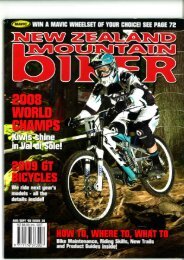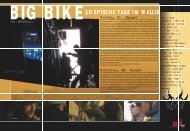What-Biking-UK_Peru - Big Mountain Bike Adventures
What-Biking-UK_Peru - Big Mountain Bike Adventures
What-Biking-UK_Peru - Big Mountain Bike Adventures
- No tags were found...
Create successful ePaper yourself
Turn your PDF publications into a flip-book with our unique Google optimized e-Paper software.
dancing in our heads, we loadourselves and our kit onto a shuttlebus and make for our hotel. Ourgroup includes former Canadiancross-country Olympian AndreasHestler, 61-year-old adventureathlete Bob Faulkner, and <strong>Big</strong><strong>Mountain</strong> <strong>Adventures</strong> owner ChrisWinter who, after hearing so muchabout <strong>Peru</strong> from gushing guidesand blown-away clients, decided heneeded to come see for himself.Such is the draw of a placewhere, as we discover a few dayslater, it’s possible to start ridingsingletrack at 12,000ft and finishwithin sight of the Pacific Ocean’scrashing waves. In between thetopographic diversity is a visualdictionary of trail surface types.In one jaw-dropping, armpumping,six-hour day, our tyresroll over slick rock, fast and flowy,steep, loose and technical terrain,plus an expansive, completelyparched river bed with a surface sosmooth and tacky you can lean yourbike like Hermann Maier carvinggiant slalom turns. Throw in aseemingly never-ending processionof lips, jumps and berms and theresult is a natural mountain biker’sparadise destination.Leaving LimaOn the morning of our first full day,we build up our bikes beforeboarding a shuttle bus and headingout of town. The contrast betweencity and trailhead is stark. Behindus looms Lima, <strong>Peru</strong>’s sprawlingcapital with a population of sevenmillion people plus another fourmillion in the dusty barrios(suburbs). In front of us is asparsely inhabited, parched andbarren landscape.Indeed, venturing into rural <strong>Peru</strong>is like travelling back in time. Lifehere hasn’t changed much since thedays of the Inca Empire, whichstarted in the <strong>Peru</strong>vian highlandsin the early 13th century. Manyinhabitants still subsist hand tomouth, cultivating small patches ofcrops and rearing farm animals toStunning scenery andsuperb singletrackcombine to give yousensory overload“Life here hasn’t changed muchsince the days of the Inca Empire”Surreal landscapes offerperfect picnic spotskeep their families fed and healthy.At its height, the Inca Empirenumbered 20 million souls andcovered nearly 800,000 squaremiles, including more than half ofSouth America’s vast western coast.But the once opulent and civilizedempire went into a rapid and bloodydecline in the 1530s, when Spanishconquistadors led by FranciscoPizarro and his brothers invaded.The Spanish conquest destroyedmany Inca monuments andbuildings, but the civilisation’sreach is evident in the network oftrails that criss-cross the mountains– and today, we’re the beneficiaries.Our first adventure starts in awide, dry valley that feeds intoswoopy, smooth singletrack thatrolls up and down like a stomachchurningfairground ride. The ridinghere is so good that you expect theplace to be packed with people but,save for a few commuting villagers,it’s empty except for our band ofgravity-obsessed riders. In fact,during the whole seven-day trip weencountered just three other riders.“For <strong>Peru</strong>vians, cycling is anexpensive sport,” explains Stein.“<strong>Bike</strong>s cost a lot of money here;much more than in North America.”No wonder then that Stein picksup most of his spare parts duringoccasional visits to the US, or asks64 February
<strong>Peru</strong> is a fascinatingand charming country“The Andes rise abruptly,leaping vertically fromthe ground like knives”Need to knowOn the long list of things to remember beforeembarking on a journey to <strong>Peru</strong>, the first isthat if you break your bike it’ll be hard to findreplacement parts. So bring as much extragear as you can jam into your bike box. A sparederailleur and extra brake pads are essential,and if you haven’t already converted to atubeless set-up, do it. There are too manyjagged rocks and spiny thorns in <strong>Peru</strong> to bemessing around with tubes.<strong>Bike</strong> choice depends on the kind of trip yousign up for. <strong>Big</strong> <strong>Mountain</strong> (www.ridebig.com),for example, offers cross-country and downhillexcursions but even on the XC trip you’ll want asturdy all-mountain steed. I rode a TitusMoto-Lite with 5in travel front and rear, andtubeless 2.35-inch Maxxis High Roller tyres. Theset-up made climbing a little slower but itwasn’t anything my granny gear couldn’tovercome. And when going downhill the extraheft made a huge difference.In terms of clothing, make sure to pack lotsof layering options: high mountain weather isnotoriously fickle, and warm sunny days canquickly turn cool and nasty. Also don’t be afraidto bring body armour — lightweight knee andelbow pads are well worth the extra weight ifyou do make an unscheduled dismount.Those keys have to behere somewhere!You need to keep your witsabout you as a mistakecould end up being messyfriends to bring equipment withthem when they visit. On this trip,for instance, I flew with two bikes:my own plus a new cross-countryrig that Stein had bought directfrom a US-based manufacturer.Even with the airline’s onerousexcess baggage charge and the 10%import tax charged at the airportcustoms desk, the new bike was stillcheaper than it would have been ifbought direct from one of Lima’sfew bike shops.Hang on tightIn the ensuing days we are treatedto a dizzying series of amazingrides, where exhilaration andexhaustion are parcelled out inequally rapid doses. Unlike themountains of North America andEurope, which ascend at a relativelygentle pace, the Andes riseabruptly, leaping vertically from theground like knives pointingupwards into the sky.One memorable morning startswith what we later dub the ‘puckerride’, a six-hour shuttle bus tripthat begins in Lima and ends in thesmall town of San Pedro de Casta.The journey between the two is awhite-knuckle ride on a bumpy onelanedirt road guarded by a rockwall on one side and a 1000ftdrop-off on the other.“That’s as scared as I’ve everbeen in a motor vehicle,” saysJustin Mark, school teacher andpart-time cross-country pro fromVancouver Island. “I’m lookingdown out of the window and thereEpic, awe-inspiring… wordsdon’t do it justice – you needto experience it for yourself66 February
“My friends and I wouldride on the bus roof; thatway we could jump off ifsomething went wrong”were times when I couldn’t evensee the road. The back wheel wasso close to the edge of the road itwas terrifying.”Stein empathises: when he firststarted exploring the area, he’dhave to reach the beginning of hisjourney by public bus. He wouldride up as far as he could by publictransport, then climb on his bikeand keep climbing until he found atrail that would take him backdown again.“Sometimes my friends and Iwould ride on the roof,” recallsStein without a hint of sarcasm.“That way if something went wrongmaybe we could jump before it wastoo late.” It sounds ridiculous, butdo a Google search for ‘<strong>Peru</strong> buscrash’ and you’ll understand theneed for a contingency plan. Rarelydoes a month pass without at leastone fatal accident.An explosive descentFortunately our scare is only that,and it’s quickly forgotten, replacedby new adventures. The day’sstarting location is another jawdropperand, at 14,000ft, most ofthe clouds float below us. This isthe magical Marcahuasi StoneForest, a surreal landscape pluckedstraight from a Dali painting.Thousands of years ago glaciersdragged, and then dropped, giantpolished rocks across the highplateau, creating a trail thathopscotches between singletrackand smooth stone faces. A smallA fast, swoopy descentlets you breathe in thebeauty of <strong>Peru</strong>Get your eye in andtake on the tech terrainfor a unique experiencemountain lake is so perfectly stillthat staring into it confuses thebrain. Which way is up?The ride down from Marcahuasiis the roughest yet, with tight,steep switchbacks and bone-rattlingrock gardens seemingly aroundevery turn. Hestler’s fork explodesearly on, drizzling oil across thetrail. But after finding the missingpart – which was jettisoned into thebushes on the trailside – and thensearching out a pair of zip-ties forreattachment, we roll on.Later, another rider sheers offhis rear derailleur. Then BobFaulkner, the adventure athlete,has a serious scare, sliding off thetrail and tumbling 15ft down thehillside. Thankfully he emergeswith just a few bumps and bruisesafter grabbing hold of someshrubbery to arrest his fall. Itcould have been so much worse.“For a moment I was very scaredfor him,” admits Alfonso, ournumber two guide, who wasriding at the tail end of the groupwhen Faulkner disappeared overthe edge.On day four, we fly from Lima toCusco. Once the thriving capital ofthe Incan Empire, today this city ofabout 400,000 people is the mainjumping-off point for touristsheaded for the ancient ruins ofMachu Pichu or trekking on the IncaTrail. It serves a similar purpose forour party; we stay one night, thenhead higher into the Andes.During the next four days weclimb above 14,000ft twice more.We descend for more miles than Ican count, look down on and thenride into the verdant Sacred Valley,eat lunch in small villages, givehandlebar rides to curious children,and generally forget about theworld we left behind.Such is the nature of the<strong>Peru</strong>vian mountain bikingexperience: your mind is soconstantly overloaded that there’slittle time for download orprocessing. Inspiring vistas, epicmoments, adrenaline shots andgeneral shock and awe come flyingat you so fast that, just days afterthe trip, it’s difficult to keep track ofexactly what happened. My journalentries read like a 13-year-oldsurfer dude’s: amazing, insane,awesome, holy shit, wow.Indeed, take this account with acaveat: that it represents only afraction’s fraction of the region’sperspective-altering experience,which must be seen, felt, tasted andsmelt to be truly understood andappreciated. And if you ever get thatchance – don’t think twice, just go.It’s really that good. ●68 March February





